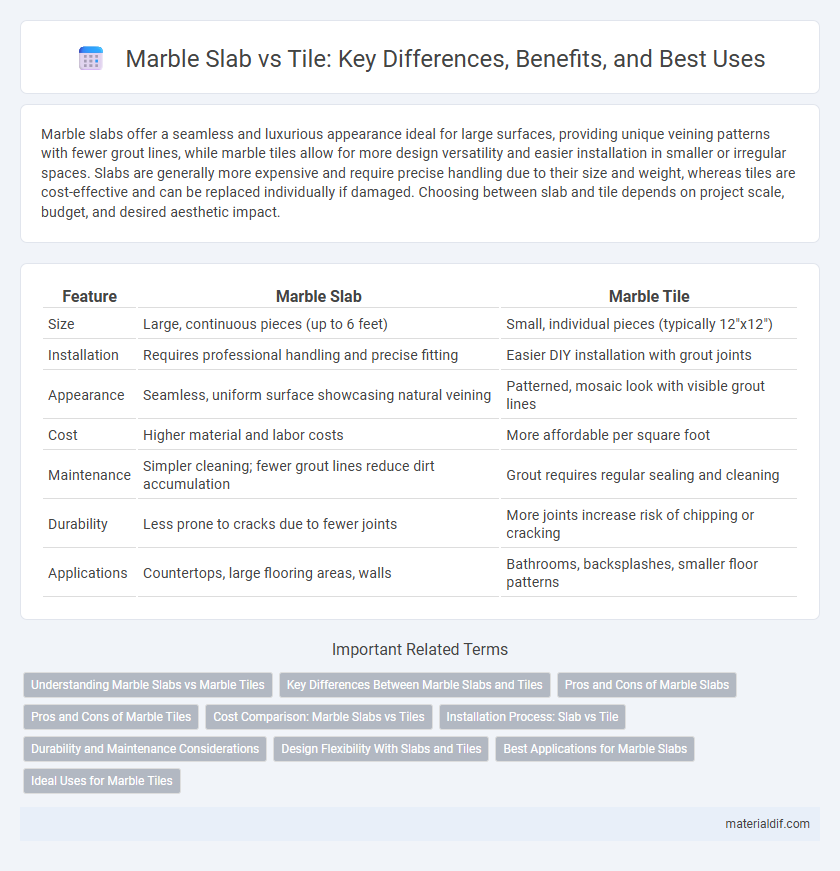Marble slabs offer a seamless and luxurious appearance ideal for large surfaces, providing unique veining patterns with fewer grout lines, while marble tiles allow for more design versatility and easier installation in smaller or irregular spaces. Slabs are generally more expensive and require precise handling due to their size and weight, whereas tiles are cost-effective and can be replaced individually if damaged. Choosing between slab and tile depends on project scale, budget, and desired aesthetic impact.
Table of Comparison
| Feature | Marble Slab | Marble Tile |
|---|---|---|
| Size | Large, continuous pieces (up to 6 feet) | Small, individual pieces (typically 12"x12") |
| Installation | Requires professional handling and precise fitting | Easier DIY installation with grout joints |
| Appearance | Seamless, uniform surface showcasing natural veining | Patterned, mosaic look with visible grout lines |
| Cost | Higher material and labor costs | More affordable per square foot |
| Maintenance | Simpler cleaning; fewer grout lines reduce dirt accumulation | Grout requires regular sealing and cleaning |
| Durability | Less prone to cracks due to fewer joints | More joints increase risk of chipping or cracking |
| Applications | Countertops, large flooring areas, walls | Bathrooms, backsplashes, smaller floor patterns |
Understanding Marble Slabs vs Marble Tiles
Marble slabs offer large, continuous surfaces ideal for countertops and flooring, showcasing unique veining and natural patterns for a seamless aesthetic. Marble tiles provide flexibility for intricate designs and smaller areas, allowing customization with varying sizes and shapes. Both slabs and tiles require sealing and maintenance to preserve their durability and prevent staining in high-traffic or moisture-prone environments.
Key Differences Between Marble Slabs and Tiles
Marble slabs offer larger, continuous surfaces ideal for countertops and flooring, providing a seamless and elegant look, while marble tiles consist of smaller units suited for detailed patterns and intricate designs. Slabs typically have fewer grout lines, enhancing durability and ease of maintenance compared to tiles, which require more grout that can be prone to staining. Marble slabs tend to be more expensive due to their size and extraction process, whereas tiles offer a cost-effective and versatile option for various applications.
Pros and Cons of Marble Slabs
Marble slabs offer a continuous, luxurious appearance with fewer grout lines, enhancing the elegance and making maintenance easier compared to tiles. Their large size allows for seamless installation, but slabs can be more expensive and challenging to handle due to weight and potential for cracking during transport or cutting. While slabs provide a premium finish ideal for countertops and large surfaces, they require meticulous sealing to prevent staining and damage from acids.
Pros and Cons of Marble Tiles
Marble tiles offer superior design flexibility and easier installation compared to slabs, fitting well in smaller spaces and intricate patterns. Their smaller size reduces the risk of cracking and allows for quicker replacement of damaged sections, enhancing long-term maintenance. However, tiles have more grout lines, which can accumulate dirt and require frequent cleaning, contrasting with the seamless and luxurious appearance of marble slabs.
Cost Comparison: Marble Slabs vs Tiles
Marble slabs typically cost between $40 and $100 per square foot, making them more expensive than marble tiles, which range from $5 to $50 per square foot. The higher price of marble slabs is attributed to their size, durability, and fewer grout lines, which reduce installation time and maintenance costs. Marble tiles offer a budget-friendly alternative with more design flexibility but require more grout, impacting long-term upkeep expenses.
Installation Process: Slab vs Tile
Marble slab installation requires careful handling due to its large, heavy size, necessitating professional equipment for lifting and precise cutting to fit seamless surfaces. Tile installation involves setting smaller individual pieces, allowing for easier adjustments and patterns but demanding meticulous grout application to prevent staining and moisture damage. Both methods require a level subfloor and sealing, but slabs typically offer faster overall installation with fewer joints compared to the time-intensive grout work of tile.
Durability and Maintenance Considerations
Marble slabs offer superior durability thanks to their larger, continuous surfaces that reduce the number of seams vulnerable to cracking or chipping, making them ideal for high-traffic areas like kitchen countertops. Marble tiles, while more prone to grout lines that can collect dirt and require regular sealing, provide easier replacement options when damaged and allow for more intricate design patterns. Both require periodic sealing and gentle cleaning with pH-neutral products to maintain their surface integrity and prevent staining or etching over time.
Design Flexibility With Slabs and Tiles
Marble slabs offer extensive design flexibility by providing large, continuous surfaces ideal for creating seamless patterns and showcasing natural veining, enhancing aesthetic appeal in high-end applications. Tiles, available in various sizes and shapes, allow for intricate designs, mosaics, and versatile installations in both flooring and walls, accommodating detailed customization and easier replacement. Choosing between slabs and tiles depends on the desired visual impact, installation complexity, and maintenance preferences within architectural and interior design projects.
Best Applications for Marble Slabs
Marble slabs are ideal for large surface areas such as countertops, flooring, and wall cladding due to their seamless appearance and minimal grout lines that enhance durability and aesthetics. Their expansive size allows for showcasing unique marble veining patterns, making slabs perfect for statement pieces in kitchens, bathrooms, and luxury hotels. Unlike tiles, slabs offer superior structural integrity and a continuous design, reducing maintenance needs and maximizing the natural beauty of marble.
Ideal Uses for Marble Tiles
Marble tiles are ideal for areas requiring precision and intricate design, such as bathroom floors, backsplashes, and accent walls due to their smaller size and ease of installation. Their uniformity allows for detailed patterns and mosaics, enhancing aesthetic appeal in residential and commercial interiors. Marble tiles also offer better slip resistance compared to large slabs, making them suitable for wet or high-traffic areas.
Slab vs Tile Infographic

 materialdif.com
materialdif.com